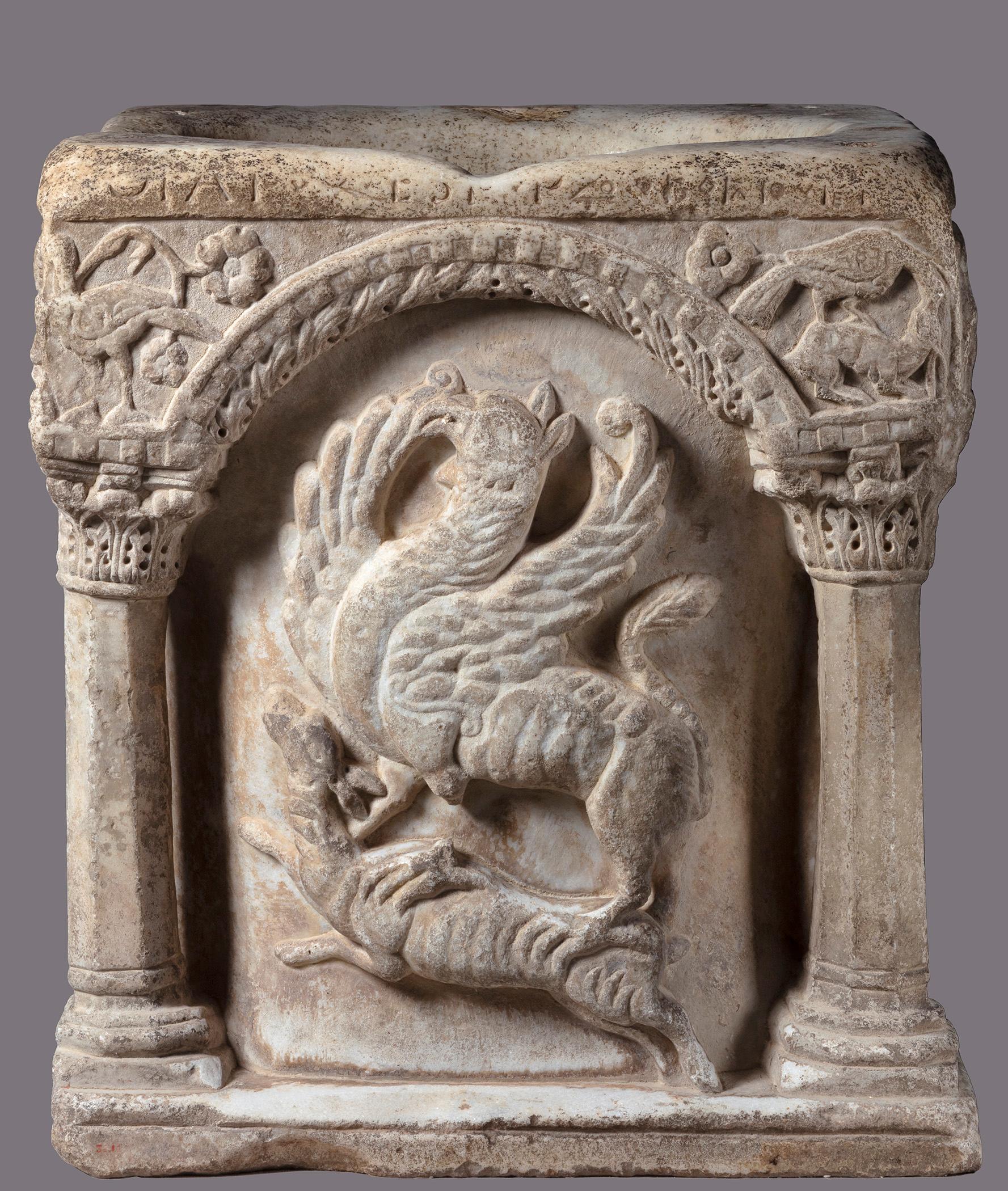Wellhead with Animal Motifs
Artist: Christofolo di Marino (Italian)
Date: 1467
Dimensions:
35 1/2 × 32 × 33 in. (90.2 × 81.3 × 83.8 cm)
Medium: marble
Place of Origin: Venice, Italy
Classification: Architectural Elements
Credit Line: Purchased with funds from the Libbey Endowment, Gift of Edward Drummond Libbey
Object number: 1936.19
Label Text:A wellhead is a stone structure that gives access to a source of water. While medieval cloisters sometimes enclosed them, this richly carved example probably came from the palace courtyard of a Venetian aristocrat. A fragmentary inscription around the top of the wellhead describes that the stone cutter, Maestro Christofolo di Marino from Padua, made this work for S[ignore] Andrea in 1467.
On this face of the wellhead, two peacocks drink from a sumptuous vase. This depiction is appropriate for a well. In addition to calling attention to physical sustenance, the birds may have symbolic meaning. Ancient tales described the immortality of peacocks, which were incapable of death or decay. Christians adapted this idea, identifying in the peacock a symbol of eternal life. A Christian observer would understand the allusion to spiritual salvation in this image: the water of baptism (the well) and the spiritual nourishment of Christian communion (the food the birds eat) were believed necessary for the attainment of a heavenly life.
Side 2:
The wellhead was created in Italy in the 15th century, a time when artists increased the naturalism of their work. However, the articulation of the ornament and bold animal motifs around this wellhead are reminiscent of Byzantine designs found in Venice and the eastern Mediterranean in previous centuries. Details like the confronting lions that affectionately embrace and the shape of the eagle’s shield are distinctly of the Renaissance and affirm a later date. The 15th-century fusion of earlier Byzantine and contemporary Venetian styles is purposeful and reflects the antiquarian tastes fashionable at the time.
Side 3:
This side depicts a griffin grasping another animal, perhaps a deer, in its fearsome claws. A fabulous creature in the lore of many cultures, the griffin combines the body, legs, and earthbound strength of a lion with an eagle’s head, wings, and ability to fly. Some medieval Christians interpreted the griffin as a symbol of Christ, who lived a noble earthly life, but who also ascended to heaven. A griffin carrying prey aloft—as here—could also be a symbol of Christ’s triumph over evil.
Side 4:
Wellheads (vere da pozzo) were distinctive features of the Venetian urban landscape. They were connected to underground tanks that served as important rainwater storage as well as man-made wells, key in a region with a limited supply of fresh water. Vere da pozzo were found in almost every public square in the city and in many private courtyards. A 19th-century survey recorded over 6,000 such wellheads remaining in place in Venice.
On this face of the wellhead, two peacocks drink from a sumptuous vase. This depiction is appropriate for a well. In addition to calling attention to physical sustenance, the birds may have symbolic meaning. Ancient tales described the immortality of peacocks, which were incapable of death or decay. Christians adapted this idea, identifying in the peacock a symbol of eternal life. A Christian observer would understand the allusion to spiritual salvation in this image: the water of baptism (the well) and the spiritual nourishment of Christian communion (the food the birds eat) were believed necessary for the attainment of a heavenly life.
Side 2:
The wellhead was created in Italy in the 15th century, a time when artists increased the naturalism of their work. However, the articulation of the ornament and bold animal motifs around this wellhead are reminiscent of Byzantine designs found in Venice and the eastern Mediterranean in previous centuries. Details like the confronting lions that affectionately embrace and the shape of the eagle’s shield are distinctly of the Renaissance and affirm a later date. The 15th-century fusion of earlier Byzantine and contemporary Venetian styles is purposeful and reflects the antiquarian tastes fashionable at the time.
Side 3:
This side depicts a griffin grasping another animal, perhaps a deer, in its fearsome claws. A fabulous creature in the lore of many cultures, the griffin combines the body, legs, and earthbound strength of a lion with an eagle’s head, wings, and ability to fly. Some medieval Christians interpreted the griffin as a symbol of Christ, who lived a noble earthly life, but who also ascended to heaven. A griffin carrying prey aloft—as here—could also be a symbol of Christ’s triumph over evil.
Side 4:
Wellheads (vere da pozzo) were distinctive features of the Venetian urban landscape. They were connected to underground tanks that served as important rainwater storage as well as man-made wells, key in a region with a limited supply of fresh water. Vere da pozzo were found in almost every public square in the city and in many private courtyards. A 19th-century survey recorded over 6,000 such wellheads remaining in place in Venice.
DescriptionSquare; sides carved in varied patterns, angular pillars with flat arches. An inscription around upper edge.
On view
In Collection(s)







